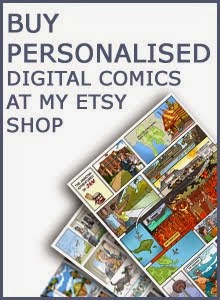I've chosen the illustration below, which is cover art for The Girly Comic (Collected Vol 2) because it's complex and because I really had to work hard at it.
This is the finished illustration:
The brief was specific-the illustration needed to ....
- have either blue or green as the dominant colour
- have a technology theme,
- feature a large central figure
- reference the comic strips inside the book
- the idea of using Ipads as tarot cards was suggested.
The reason I was asked to draw the cover is because I've got a number of strips in the collection. One of them is Chess for Witches, a comic that I adapted from a short story written by a co-worker in my first job. Here is a page from it:
My art style has developed since then, but I liked it and was looking forward to revisiting the character. The original brief mentioned the comic Madame Xanadu as inspiration, so I looked at some of the old comics:
I wanted to show the main character leaning forward towards the viewer and was having trouble getting the perspective right, so I photographed myself in the same pose and used the photographs for reference. When I did the original comic I didn't have much idea how to draw people, so I used myself as source material. (This is the only part of the process that I'm not putting online, because the photos are too embarrassing)
If I am struggling with something and cannot get reference myself I will search images online. Apparently some artists think that everything should come from imagination or from life. That might work if I had a less realistic art style but in practice most artists I've known use reference.
Paul Duffield built 3D sets for the most complicated layouts in Warren Ellis's comic Freakangels and rotated them to get the right perspective. Mine is not the most complex procees out there.
The Ipads became mobile phones because they were nearer the size of tarot cards Below is an initial sketch:
I finished the rest of the body, flipped and traced the image a couple of times on a light box to make sure it wasn't wonky (the face is still a bit skewiff in this sketch) and traced it out in thick black marker. I pencil final artwork on the back of cheap A3 supermarket paper and then ink on the opposite side using a light box. This means I can redraw it as many times as I want without paying for expensive tracing paper, but it loses some detail, so the lines have to be clear.
The image often ends up the wrong way round because I trace and flip it so many times- but that's something I can correct later in Photoshop. This is the clean line art. I had such a hard time with the figure that I drew the mobile phones at the bottom of the page in separately:
I scanned it into my computer and adjusted it in Photoshop using the Auto Levels and Brightness/Contrast Tools.
I drew and scanned the background separately and added it using Photoshop. At this point, I also decided that the perspective on the pointing hand was horrible and needed to be redrawn
It's looking a bit more like the final version now, but notice that the actual illustration has much more blank space at the bottom? I sent it to the client at this stage , they liked it but asked for more room for the logo. It's easy to change things at this stage. When you add colour, it becomes a lot more difficult.
Next stop: Colour!













No comments:
Post a Comment